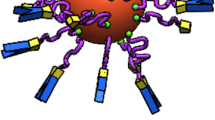Abstract
Understanding the capabilities and limitations of nuclear import is crucial to efficient delivery of macromolecules and nanoparticles for diagnosis and targeted therapy of diseases. Here we report the Tat peptide-mediated import of different cargos into cell nucleus, including dye-labeled streptavidin protein, 43 and 90 nm fluorescent beads, as well as ~20 nm quantum dots for kinetic measurements. Our results revealed significant differences between Tat- and NLS-mediated nuclear import: unlike delivery with the NLS, Tat peptide-based delivery is not inhibited by WGA blockage nor does it require ATP. Surprisingly, Tat peptide was able to import 90 nm beads into the nuclei of digitonin-permeabilized cells, suggesting that its interaction with the nuclear envelope follows a mechanism different from that of NLS. The import kinetics was quantified using Tat peptide-conjugated QDs, yielding a kinetic constant of 0.0085 s−1. Taken together, our results suggest that, compared with NLS, Tat peptide-mediated nuclear import is faster, follows a different pathway, and is capable of importing large nanoparticles. These results have significant implications for the development of new approaches for delivery of cargo into the nuclei of living cells.






Similar content being viewed by others
References
Adam, S. A., R. S. Marr, and L. Gerace. Nuclear protein import in permeabilized mammalian cells requires soluble cytoplasmic factors. J. Cell Biol. 111:807–816, 1990.
Adam, S. A., R. Sterne-Marr, and L. Gerace. In vitro nuclear protein import using permeabilized mammalian cells. Methods Cell Biol. 35:469–482, 1991.
Becker-Hapak, M., S. S. McAllister, and S. F. Dowdy. TAT-mediated protein transduction into mammalian cells. Methods 24:247–256, 2001.
Chan, W. C., and S. Nie. Quantum dot bioconjugates for ultrasensitive nonisotopic detection. Science 281:2016–2018, 1998.
Cserpan, I., and A. Udvardy. The mechanism of nuclear transport of natural or artificial transport substrates in digitonin-permeabilized cells. J. Cell Sci. 108(Pt 5):1849–1861, 1995.
Curnow, P., H. Mellor, D. J. Stephens, M. Lorch, and P. J. Booth. Translocation of the cell-penetrating Tat peptide across artificial bilayers and into living cells. Biochem. Soc. Symp. 199–209, 2005.
Duverger, E., C. Pellerin-Mendes, R. Mayer, A. C. Roche, and M. Monsigny. Nuclear import of glycoconjugates is distinct from the classical NLS pathway. J. Cell Sci. 108(Pt 4):1325–1332, 1995.
Dworetzky, S. I., R. E. Lanford, and C. M. Feldherr. The effects of variations in the number and sequence of targeting signals on nuclear uptake. J. Cell Biol. 107:1279–1287, 1988.
Efthymiadis, A., L. J. Briggs, and D. A. Jans. The HIV-1 Tat nuclear localization sequence confers novel nuclear import properties. J. Biol. Chem. 273:1623–1628, 1998.
Hagstrom, J. E., J. J. Ludtke, M. C. Bassik, M. G. Sebestyen, S. A. Adam, and J. A. Wolff. Nuclear import of DNA in digitonin-permeabilized cells. J. Cell Sci. 110(Pt 18):2323–2331, 1997.
Kaplan, I. M., J. S. Wadia, and S. F. Dowdy. Cationic TAT peptide transduction domain enters cells by macropinocytosis. J. Control. Release 102:247–253, 2005.
Koch, A. M., F. Reynolds, M. F. Kircher, H. P. Merkle, R. Weissleder, and L. Josephson. Uptake and metabolism of a dual fluorochrome Tat-nanoparticle in HeLa cells. Bioconjug. Chem. 14:1115–1121, 2003.
Levchenko, T. S., R. Rammohan, N. Volodina, and V. P. Torchilin. Tat peptide-mediated intracellular delivery of liposomes. Methods Enzymol. 372:339–349, 2003.
Newmeyer, D. D., and D. J. Forbes. Nuclear import can be separated into distinct steps in vitro: nuclear pore binding and translocation. Cell 52:641–653, 1988.
Pante, N., and M. Kann. Nuclear pore complex is able to transport macromolecules with diameters of about 39 nm. Mol. Biol. Cell 13:425–434, 2002.
Ribbeck, K., and D. Gorlich. Kinetic analysis of translocation through nuclear pore complexes. EMBO J. 20:1320–1330, 2001.
Ribbeck, K., and D. Gorlich. The permeability barrier of nuclear pore complexes appears to operate via hydrophobic exclusion. EMBO J. 21:2664–2671, 2002.
Torchilin, V. P. TAT peptide-modified liposomes for intracellular delivery of drugs and DNA. Cell. Mol. Biol. Lett. 7:265–267, 2002.
Vaysse, L., L. G. Gregory, R. P. Harbottle, E. Perouzel, O. Tolmachov, and C. Coutelle. Nuclear-targeted minicircle to enhance gene transfer with non-viral vectors in vitro and in vivo. J. Gene Med. 8:754–763, 2006.
Wadia, J. S., R. V. Stan, and S. F. Dowdy. Transducible TAT-HA fusogenic peptide enhances escape of TAT-fusion proteins after lipid raft macropinocytosis. Nat. Med. 10:310–315, 2004.
Wilson, G. L., B. S. Dean, G. Wang, and D. A. Dean. Nuclear import of plasmid DNA in digitonin-permeabilized cells requires both cytoplasmic factors and specific DNA sequences. J. Biol. Chem. 274:22025–22032, 1999.
Wolff, B., W. C. Willingham, and J. A. Hanover. Nuclear protein import: specificity for transport across the nuclear pore. Exp. Cell Res. 178:318–334, 1988.
Yamamoto, N., and X. W. Deng. Protein nucleocytoplasmic transport and its light regulation in plants. Genes Cells 4:489–500, 1999.
Yoneda, Y., N. Imamoto-Sonobe, M. Yamaizumi, and T. Uchida. Reversible inhibition of protein import into the nucleus by wheat germ agglutinin injected into cultured cells. Exp. Cell Res. 173:586–595, 1987.
Zhao, M., M. F. Kircher, L. Josephson, and R. Weissleder. Differential conjugation of tat peptide to superparamagnetic nanoparticles and its effect on cellular uptake. Bioconjug. Chem. 13:840–844, 2002.
Acknowledgments
This work was supported by NIH Roadmap Initiative in Nanomedicine through a Nanomedicine Development Center award, 1PN2EY018244 (GB), and by the Office of Science, Department of Energy grant DE-FG02-04ER63785 (GB).
Author information
Authors and Affiliations
Corresponding author
Rights and permissions
About this article
Cite this article
Nitin, N., LaConte, L., Rhee, W.J. et al. Tat Peptide Is Capable of Importing Large Nanoparticles Across Nuclear Membrane in Digitonin Permeabilized Cells. Ann Biomed Eng 37, 2018–2027 (2009). https://doi.org/10.1007/s10439-009-9768-0
Received:
Accepted:
Published:
Issue Date:
DOI: https://doi.org/10.1007/s10439-009-9768-0




